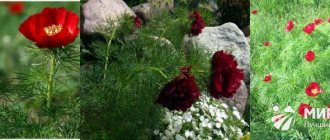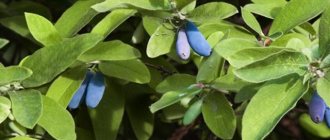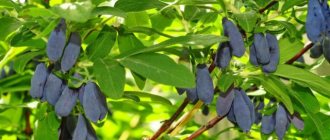Description and history of the peony variety "Sarah Bernhardt"
https://domashniecvety.ru/wp-content/uploads/8/3/6/8368fcdb40b81c69229f83f27740586b
These varieties have existed for more than 100 years. Pierre Lemoine, who breeds varieties of peonies and lilacs, is a famous person. His selection works delight the most capricious critics and make them understand what beauty is. Varieties "Sarah Bernhardt" have repeatedly received awards from the Royal Horticultural Society in England. It was received for increased decorative and garden characteristics.
According to the description, the Sarah Bernhardt peony was created back in 1906. Think about it, it is thanks to its beauty that it has occupied maximum positions in ratings for more than a century. It is known that the name of the variety was given in honor of the breeder’s favorite actress, as a sign of love and respect for her work.
The following video will introduce you to the variety in more detail.
Compatibility of peony with other crops
Before planting, it is recommended to find out what peonies go with and what plants they do not belong next to. Gardeners say that these flowers are in perfect harmony with other plants. They can be used for decoration:
- parks;
- rock gardens;
- landscape massif;
- homestead and garden areas.
Most often, peonies are combined with other crops depending on the shade. The luxury of white varieties is effectively set off by poppies, irises, bluebells, honeysuckle bushes, daylilies and sage. Exquisite, royally chic red flowers are recommended to be planted next to decorative onions. Sarah Bernhardt Pink fits effectively into a composition with barberry bushes or an elegant thuja. You can combine it with hellebores.
Using this variety of peonies, it is easy to create a luxurious garden of continuous flowering. Such a site will smell fragrant and delight the eye with rich shades from spring to autumn. To obtain a similar result, it is recommended to combine peonies with crocuses, irises, daffodils, zinnias, petunias, lilies, godetias, phlox, chrysanthemums or asters.
Characteristics of the variety
Peonies of this variety have a delicate, but rich, dense white-pink hue. There are red, white, light lilac, yellow and milky varieties. To better get acquainted with the appearance of the crop, pay attention to the structure of the plant:
- petals are double or semi-double, concave;
- the buds are large, single, reaching 15-20 cm in diameter;
- plant stems are long, up to 1 m;
- aroma, juicy, persists throughout flowering;
- leaves are dark green, dissected.
The main advantage of these peonies is that the leaves retain their natural shade and freshness throughout the growing season. In autumn or late summer, with early cooling, they turn burgundy, so the bush is always attractive in appearance.
Milk-flowered peonies "Sarah Bernhardt" are frost-resistant and can easily tolerate temperatures dropping to -25 degrees. The main recommendation for the gardener is to cut the leaves on time. If they freeze, the root system will suffer and the beautiful flower will get sick.
An additional advantage is high resistance to various diseases. Owners of this variety have no problems; the plant always pleases them with its appearance and surprises them with its flowering.
The bush looks elegant. It does not bend under the weight of its weight and does not fall apart, does not bend to the ground with gusts of wind.
https://azalia-tula.ru/upload/resizer2/24/c77/c774f87a2063931960470c2c972d096a
Description
Peony Sarah Bernhardt Unique™ (Peony lactiflora 'Sarah Bernhardt Unique', Herbaceous Peony, Paeonia Lactiflora Grp 'Sarah Bernhardt Unique', Garden Peony). This beautiful peony is prized for its strong aroma and unusual color. Late bloomer. It was received in 1995. Named after French actress Sarah Bernhardt. The name of the variety suggests that the flower will be unique. And he really lives up to his name. And all because of the dark stripes, like Monet paints, on the powdery pink petals. Even when the peony opens completely, it will retain its beautiful pink color. There is another, no less popular variety with a similar name, Red Sarah Bernhardt peony (it has a dark red flower with a copper tint).
- The Sarah Bernhardt Unique™ variety has very good flower production!
- Excellent health.
- Beautiful biennial plants.
- Large, heavy flower buds that open easily.
- Grandiose peony bloom! The huge, dense flowers are hard to miss.
- They provide a spectacle of color all summer long.
- Double flowers rise on strong stalks and exude a sweet perfume aroma.
- Their shape is pink.
- The lower petals are large.
- The inner petals are smaller, concave and toothed.
- All stamens are transformed into petals.
- The flower size is about 17 cm in diameter.
- The foliage is dark green and glossy. It provides the perfect contrast for the stunning blooms.
- The bush grows to a height of 95 cm, with a spread of up to 60-90 cm.
Read also: Pruning yoshta in the fall for beginners
Peony milky-flowered herbaceous perennial plant. Please note that milky-flowered peony sometimes goes by other names: garden peony, Chinese peony. This is a perennial herbaceous plant native to Siberia and China. It has convex roots, the stems erected from them are slightly woody at the base. The flowering period of peonies is extended: they bloom in late May and early June (single-double and semi-double peonies) or in June (double peonies). They thrive when bearded irises finish blooming. The color of cultivated varieties is white, pink, carmine or purple, in various shades. Some flowers have a scent.
The Sarah Bernhardt Unique™ peony variety is very durable. It can grow in one place for up to 10-15 years, subject to good care. It does not tolerate transplantation well, so you need to decide in advance on the planting site. A support with a wire frame or wooden stakes is needed to support heavy flowers and to prevent the bush from falling apart. It is very important that peonies are grown in deep, humus-rich soil that is sufficiently moist. They prefer sun in cooler climates and partial shade in warmer climates with protection from the wind. Peonies are long-lived plants, but do not like frequent replanting. So, carefully choose a place in your garden and prepare the planting hole well!
Application: looks beautiful on the lawn, as well as under bushes of ornamental plants. Recommended for large single-species or group plantings.
Propagated by dividing the bush every 5-6 years. Requires abundant fertilizer. It is better to use organic fertilizers than mineral ones (peonies do not tolerate calcium). In summer, you can fertilize with liquid manure. In winter, the plants should be covered with spruce branches.
This variety will delight you with its flowering in the year of planting (if planted in spring) or the next year (if planted in autumn). However, if this is not the case, then do not be upset. Your plant may need time to adapt to its new location. Build your collection of milky-flowered peonies! If you decide to buy herbaceous peonies, then IP Kharchenko will help you do this very easily and conveniently.
Varieties
Among the herbaceous peonies “Sarah Bernhardt”, flower growers distinguish the following varieties:
- Peony "Red Sarah Bernhardt". It has a pleasant and persistent aroma and is presented in a bright color palette. In it you can find soft pink, purple, rich red inflorescences. The flowers are double, reach 80 cm in height, and the diameter of the bud is at least 15 cm. The leaves are openwork, covering the entire stem. Due to its high decorative value, the flower is often used in landscape design and floristry. The variety is resistant to diseases. Red sarah bernhardt peonies are ubiquitous and can often be found in garden plots.
- Peony "White Sarah Bernhardt". An elegant plant that is used for decoration. The buds are snow-white, their petals are delicate, rounded, and the edges are painted in a silvery tint. The leaves are juicy and green. The advantage of the plant is its unpretentiousness; the main thing is to organize feeding on time.
- "Sarah Bernhardt Unique." The buds of this variety have a soft pink tint; they shimmer like pearls in the light. Rapid flowering of the plant begins in the summer. Often used in landscape design, used for organizing multiple and single plantings.
Attention! If you don’t know what variety is growing in your front garden. don't try to identify him by his photo. As a result of the work of modern breeders, many new varieties have been developed and some of them have a certain similarity.
https://cveti-rasteniya.ru/wp-content/gallery/piony-sara-bernar/4
Peonies after flowering
After flowering, caring for peonies is also easy; it is enough to take the necessary care measures.
Transfer
Transplantation is required when the old rhizome has already grown so much that there is not enough room for it. Then the plant is moved to a new location by dividing the rhizome. This will rejuvenate the flower and give it new strength for growth and development.
Trimming
It is very important to remove all wilted flowers, they can cause the development of many infectious diseases. Drastic pruning of herbaceous peonies is carried out before wintering - the above-ground part is completely removed, leaving only small parts of the stem of 15 cm each.
Preparing for winter
Since this variety can winter at temperatures down to -40°C, preparing for winter will not be difficult. The remaining stems are hilled to the maximum possible height. On top they are covered with cut parts of an adult plant. No other cover is required. They will survive winter frosts well under a layer of snow.
How to plant
Peony "Sarah Bernhardt" requires compliance with individual rules when carrying out planting work. But difficulties in the process are unlikely to arise if you follow the given algorithm:
- Planting is carried out in late summer or early autumn.
- Select soil for the plant. The substrate must be saturated with clay and sand, and the reaction must be slightly acidic. If the substrate is very loose, the situation can be corrected by adding organic compounds; it is permissible to use humus. Clay is often mixed with river sand. You should not choose swampy areas for planting. Excessive moisture levels lead to water stagnation, which negatively affects the peony root system.
- Peonies respond positively to light, so they should not be placed under the shade of trees and shrubs with a lush crown. Only light shading is permissible, provided that the bush receives a portion of the morning sun.
- When planting several seedlings, maintain distance between plants. It should be at least 1 m. This is due to the fact that the bushes will noticeably increase in growth.
- Take time to prepare planting holes. The root system of the plant grows deeper, so the recess must be at least 60 cm. Place drainage at the bottom of the prepared hole to prevent possible soaking of the root system.
- The hole should stand for a day, after which they begin planting. Try not to deepen the root collar, otherwise rot will affect the plant.
- Do not compact the substrate too hard. Simply water the plant and then add soil after it has settled.
Attention! If you visit the site periodically and cannot ensure constant moisture control of the substrate, arrange mulch. It will retain moisture and prevent drying out.
Application in landscape design
Peony Sarah Bernhardt is a spectacular ornamental plant. It looks good in both single and group plantings.
Read more Feeding peonies in the fall and preparing for winter
The flower can be planted along fences and other buildings, creating a beautiful background. This perennial will look good in the background or in the center of flower beds and mixborders.
Bushes can be planted in a line to zone the area or create a background
Peonies go well with a variety of plants. Their neighbors can be astilbe, godetia, pelargonium, petunia, zinnia.
By autumn, Sarah Bernhardt has already faded, but due to the foliage it retains its decorative effect. During this period, the perennial can be used as a background for asters, phlox, and chrysanthemums.
A combination of different shades of one perennial looks impressive
Comment! Peonies should not be planted next to representatives of the Ranunculaceae family. They quickly deplete the soil and suppress other flowers.
Bushes can be planted individually on the lawn, creating accents.
When choosing neighbors, it is important to remember the short flowering period, which is compensated by voluminous openwork foliage. It can be used to fill empty spaces when less lush plants are nearby.
The contrast of white and red colors looks beautiful
Even one peony bush will revive the lawn or green spaces
How to care
Peonies "Sarah Bernard" are completely unpretentious in care. The main task of the gardener is to follow the basic rules of maintenance:
- regularly weed the beds;
- loosen the soil near plants and row spacing;
- carry out pruning;
- remove buds in time after flowering;
- provide watering;
- apply fertilizers.
https://static.tildacdn.com/tild3436-6135-4532-a238-373963313763/image
The rules indicated in this list are the same for all peonies. If you follow them, the plants will remain grateful and will constantly delight you with their beauty. Particular attention should be paid to watering - if it is provided poorly, the flower will not be able to develop. Fertilizers must be applied according to a special scheme, otherwise the plant will not bloom magnificently.
Top dressing
If the soil for growing peonies of the “Sarah Bernhardt” variety is chosen correctly, for 2-3 years you don’t have to think about organizing fertilizing. Next, fertilizers are applied 3 times per season.
In mid-summer, it is recommended to use an infusion of mullein or bird droppings. Consumption is determined depending on the age of the plant, subject to the condition - 3 liters of ready-made fertilizer per 1 adult bush.
In the spring, the process of applying fertilizing is limited to mulching the tree trunk area around the bushes. For this purpose, use any vegetable mulch mixed with wood ash. The latter acts as a top dressing.
In the fall, it is advisable to apply superphosphate. It will provide the plant with the necessary supply of nutritional components and allow it to fully prepare for winter rest. Fertilizing is organized at the rate of 2 tbsp of product per 10 liters of water. This volume is poured under each bush.
Watering
Excessive moisture is contraindicated for the plant. During the period of active growth, irrigation is carried out once a week. During the flowering period, if it is hot outside, the frequency of watering is doubled and carried out 2 times a week. Keep in mind that infrequent but abundant watering is the best solution when growing peonies. Recommended consumption is 3 liters for 1 adult bush.
https://7dach.ru/uploads/images/34/89/13/2018/07/09/33e2c5
It is better to carry out the procedure in the evening or early morning. If it’s hot outside, watering the flower during the day is pointless. Moisture will not have time to penetrate into the deep layers of the soil.
Attention! Remove the buds after they dry out. If this is not done, the bush will suffer from fungal diseases.
Features of cultivation
Peony Sarah Bernhardt is an unpretentious plant, however, it also requires regular care, including:
- Watering. It is important to maintain a balance here. The bush equally does not like drought and high humidity. During the period of bud formation, the plant is irrigated every 3 days (in dry times it is allowed to do this more often), and when it blooms, one is enough. An adult bush requires at least 15 liters of water for one watering.
- Feeding. According to gardeners, in the first 2-3 years the Sarah Bernhardt peony does not need feeding. Later, you can feed the soil in the area of the bush with superphosphates or organic matter 3 or 4 times a year.
- Loosening and removing weeds. These procedures should be carried out as needed. If the soil is covered with mulch, it is not necessary to loosen it.
Advice! Dried flowers need to be cut. This will improve the appearance of the plant and protect it from fungal diseases.
Reproduction
In the case of peonies of the “Sarah Bernhardt” variety, propagation is optimally ensured by dividing the rhizomes. At the end of summer, the bushes are dug up with a shovel and carefully separated, trying not to damage the roots.
The seed method is also acceptable, but the grower will have to wait a very long time until a shrub capable of flowering appears. It takes about 3-5 years from sowing the seeds to active bud formation on the bush.
https://xn—-7sbaabv9dainmaro1f.xn--p1ai/ssl/u/6f/39f1727a5511ea98a9ec52ecf8b1bc/-/%D0%A1%D0%B0%D1%80%D0%B0%20%D0%91%D0%B5 %D1%80%D0%BD%D0%B0%D1%80%D0%B4
Diseases and pests
Plants are resistant to the development of various diseases, but certain pathologies can cause trouble for the grower:
- Gray rot. The most common disease among peonies. Young bushes are susceptible to it. At the initial stage of development of the problem, the leaves become covered with plaque. Treatment should be started immediately, otherwise the culture will die.
- Rust. It noticeably worsens the appearance of the bush; it becomes covered with ugly, pronounced red spots. The risk of developing the problem increases with dense plantings. Most often, rust affects peonies if spring is rainy. In this case, early treatment with fungicides is indicated.
- Mosaic. Yellow or light green stripes appear on the leaves. It is impossible to cure the disease, so it is recommended to destroy the bush immediately. If this is not done, the local problem will become widespread and quickly spread throughout the garden.
Peony connoisseurs will find the following video useful. It presents the best varieties of aromatic plants.
Peonies of the "Sarah Bernhardt" variety have deservedly occupied high positions in the rankings for a century. This variety can be considered the best in many respects, but flower growers value it for its lush flowering and lack of special care requirements. If you follow all the rules, the likelihood of being affected by pests and diseases will be minimal, and the peony bush will delight you with flowering for many years.











